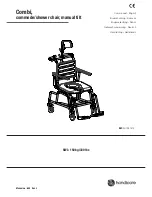
IV.
Troubleshooting
The following are common questions you may have regarding PMV
®
1. When the PMV was put on the tracheostomy tube, it seemed to be
harder to breathe, what do I do?
The PMVs open very easily. The PMV
®
®
™
) open even easier than the PMV
®
005 (white) and
PMV
®
™
). If it appears that you are having trouble
breathing with the PMV in place, remove the PMV immediately.
The following are several things you should consider trying before
a. Check your position and the position of the tracheostomy
tube
. If possible, sit upright in a chair or bed as this is generally
most comfortable and will allow for full movement of your diaphragm
and other respiratory muscles. It should also allow for air to pass
easily around the tracheostomy tube and out of your mouth and
nose. A small child may be most comfortable on a caregiver’s lap.
Also, make sure that the tracheostomy tube is not sitting crooked at
the neck as this can mean that it is crooked in the airway too. If the
tracheostomy tube is not sitting straight in the airway, it can block
tracheostomy tube and out of the nose and mouth.
b. Check to be sure that the tracheostomy tube cuff is
completely deflated
.
If you have a cuffed tracheostomy tube,
around the tracheostomy tube decreasing your ability to fully
completely deflated
when you feel suction on
the syringe while evacuating the air. Occasionally, even if the cuff
move around the tube. If the problem persists, contact your doctor
or healthcare professional for evaluation.
c. Suction airway through the tracheostomy tube and also the
mouth again if needed.
breathing can become more difficult and make you uncomfortable
while the PMV is worn.
d. Check amount and type of secretions coming from the
tracheostomy tube.
A weak cough requiring frequent suctioning,
or an infection that is causing secretions to be thicker than usual
needs to be considered when using the PMV
®
. These conditions
should not stop you from trying the PMV, but you may want to
wait to use the PMV until the secretions become thinner and more
your secretions have become thicker or have changed in any way.
e. Anxiety.
anything different involving your tracheostomy tube is normal.
to make you feel more comfortable while using the PMV. Reading
(available free of charge from Passy-Muir Inc.) and talking to your
understanding of how the PMV works and will provide you with
more confidence.
After you have checked each point listed above, you may want to try
placing the PMV on the tracheostomy tube again following the same
Placement of the PMV
2. All steps in #1 above have been checked, the PMV was put back
on the tracheostomy tube and it was still harder to breathe.
What could be causing this?
a.
If you are not able to tolerate the PMV you may need to be evaluated
by your doctor or a specialist such as an Ear, Nose and Throat Doctor
(ENT or Otolaryngologist) or Lung Doctor (Pulmonologist). The doctor
will look for a narrowing or softening of the walls of the trachea
(windpipe) that might make it collapse, a build-up of scar tissue, or
problems with the vocal cords. Any of these things can make it difficult
or impossible to use the PMV until the problem is corrected.
b.
around the tube and into the
upper airway
through the vocal cords
may need to put in a smaller tracheostomy tube or a tracheostomy tube
without a cuff in order for you to be able to use the PMV.





































